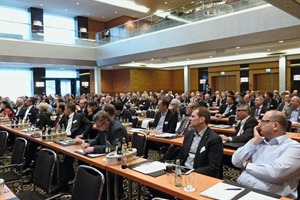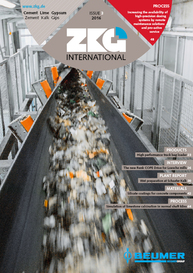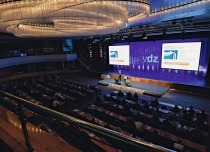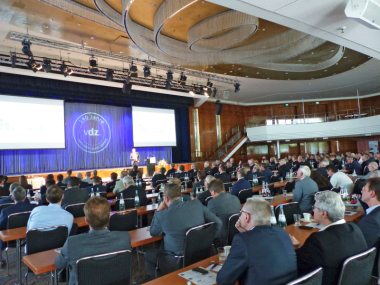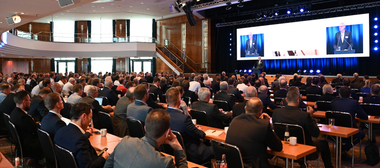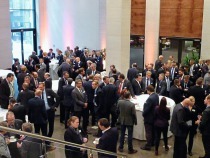Focus on environmental technology
and process engineering developments
It’s a long tradition that the VDZ Technical Conference on Cement Process Engineering takes place on Weiberfastnacht (“Women’s Carnival”), during Germany’s annual “Karneval” festivities. This year, too, nearly 200 specialists from the cement industry and allied disciplines met for the kick-off of the street pageant in Düsseldorf/Germany on 04.02.2016.
The conference opened with a speech of welcome by Dr.-Ing. Volker Hoenig on behalf of the German Cement Works Association (VDZ). The event was presided over by the chairman of the VDZ Environment and Process Engineering committee, Dipl.-Ing. Bernward Goedecke, who firstly summarised the work of the committee and its results in his activity report.
The paper on “Safety nets for protection when working in pre-heaters” by Andreas Häußermann, Dyckerhoff GmbH, was devoted to the topic of occupational health and safety. Häußermann focussed on an alternative to safety scaffolding for masonry inspections in the pre-heater. Dyckerhoff, in cooperation with the Swiss company Geobrugg AG, has developed a new safety structure. The use of multi-layer safety nets in combination with retarder bars thus significantly enhances safety for work in the riser duct.
Dipl.-Ing. Jan Althammer, Schwenk Zement KG, presented his address, drafted jointly with Richard Morris, on “Increasing the efficiency of feed materials grinding via integration of a vertical mill at the Schwenk Zement KG cement plant”. The project for integration of a new vertical roller mill during going operation was illustrated on the basis of its successive chronological progress. An intensive project planning phase proved here to be recommendable, in view of the then correspondingly shorter construction period.
Thomas M. Kläusli, AVA-CO2 Schweiz AG, attempted an answer to the question of “Can HTC technology assure the future thermal utilisation of treatment sludge in the cement industry?”. Kläusli discussed hydrothermal carbonisation for the use of treatment sludge as a potential alternative fuel perspective for the cement industry. His deliberations also took account of the phosphorus recovery aspect.
Ing. Thomas Neuwirth, w&p Zement GmbH, spoke on the “Preparation of alternative fuels using the rocket mill at the Wietersdorf plant”. The pilot rocket mill installation developed in cooperation with A TEC in Wietersdorf/Austria for the preparation of alternative fuels was firstly presented. The subsequent deliberations reported on initial operating experience and also discussed improvements and potentials for further development.
The project planning and introduction of a “Fluff-drying system at Dyckerhoff GmbH’s Nowiny plant” was examined by Wojciech Rabajczyk, Dyckerhoff Polska Sp. z o.o.. Solutions to problems after commissioning and improved fire safety provisions rounded off his discussion of this project.
“Rugby optimisation of the bypass and of the use of alternative fuel” was the topic selected by Dr. Michael Müller-Pfeiffer, Cemex Deutschland AG. A particular focus here was the effect on the chlorine bypass in the Rugby cement plant in Rugby/UK. In addition to modifications for elimination of the meal losses confirmed in the CFD model, process stabilisation by means of metering in of chalk also achieved further improvements in the chlorine bypass.
Rob van der Meer, HeidelbergCement Group, Cimenteries CBR S.A. Brussels, spoke on “Pilot tests for post-combustion CO2 removal at the Brevik cement plant”. Four different technologies for removal of CO2 are being tested at HeidelbergCement subsidiary Norcem’s Brevik cement plant in Norway. The first results following an up to now two-year test phase showed that technologies for CO2 removal exist, but are at differing stages of development. Carbon capture and storage (CCS) is now technologically possible, but not yet economically feasible. It will require greater financial support, from public funds, as well, if it is to be implementable within the next ten to fifteen years.
The Wietersdorf cement plant in Austria came into focus for the second time on this day in the address on “Initial operating experience with the ExMercury Hg emissions reduction system” by Dipl.-Ing. Florian Salzer, w&p Zement GmbH.
w&p Zement GmbH, in cooperation with Scheuch GmbH and A TEC, has developed at this plant a system for reduction of mercury. This research project is to continue until mid-2017, but it has already been possible, after one year of operation, to achieve extremely good results in reduction of emissions (see ZKG 9/2015, pp. 38–44; Interview with Florian Salzer on this subject: ZKG 9/2015, pp. 34–36).
The final address was given by Paul Bektschev and Julian Lindhorst, HeidelbergCement AG, on the topic of “Energy optimisation of a ball mill at HeidelbergCement AG’s Ennigerloh cement plant”. The ball mill, used in 90 % of all cases in Germany, is the most important grinding machine, but is also a great consumer of energy and therefore harbours, at the same time, great potentials for savings. Perfect mechanical condition of the grinding chamber was stated as a basic precondition for realising these potentials. The size distribution and quality of the mill balls are also decisive in the success of comminution using this machine. The classifier and the mill control system can also influence exploitation of the machine’s potential. The total of all these provisions results in the greatest successful savings.
At the close of the event, Bernward Goedecke drew attention to the annual VDZ conference to be held in Düsseldorf on 27.09.–28.09.2016, which will examine various questions of German and European industrial and economic policy, and also current topics in cement and concrete technology.
//www.vdz-online.de" target="_blank" >www.vdz-online.de:www.vdz-online.de

